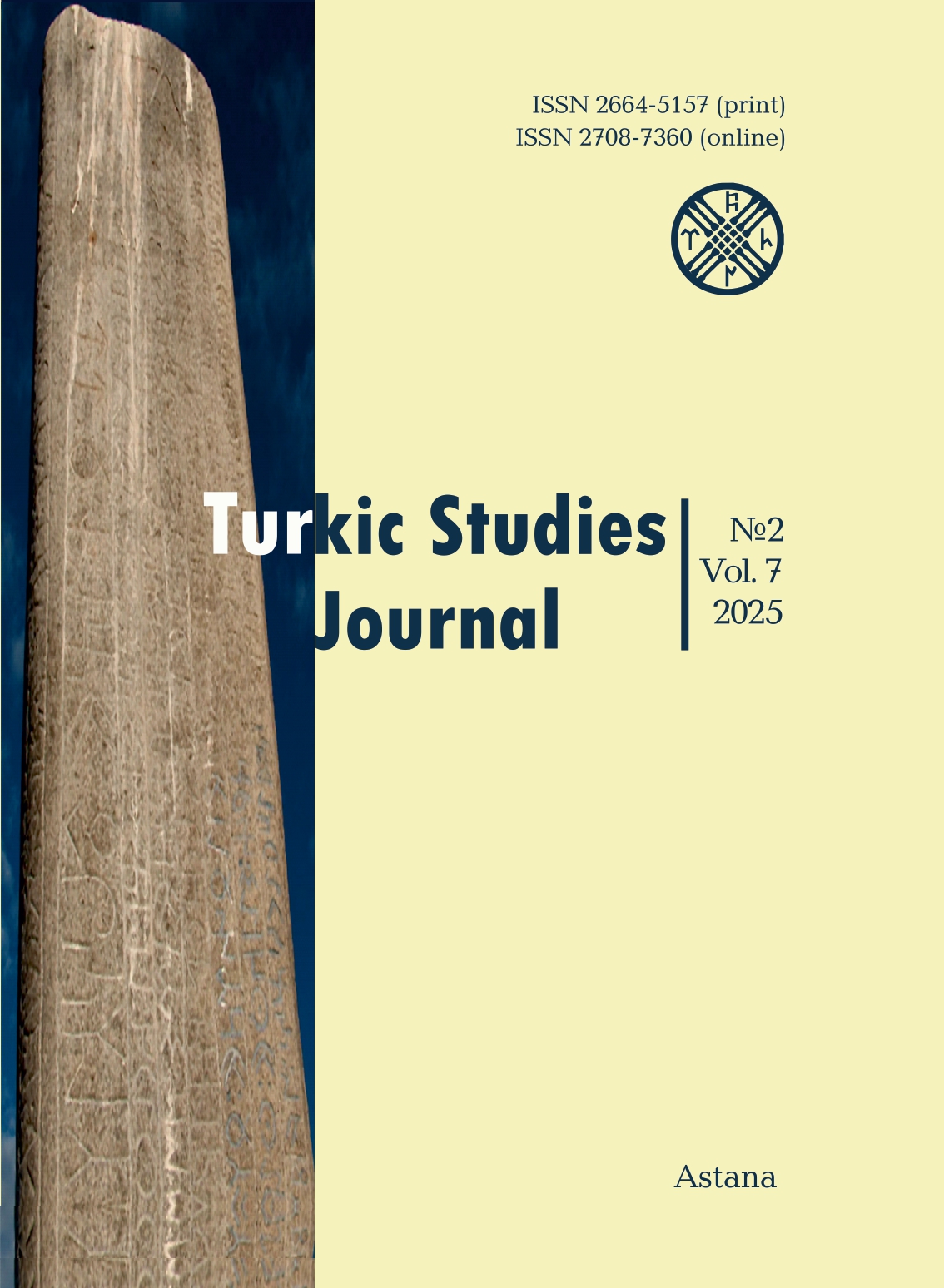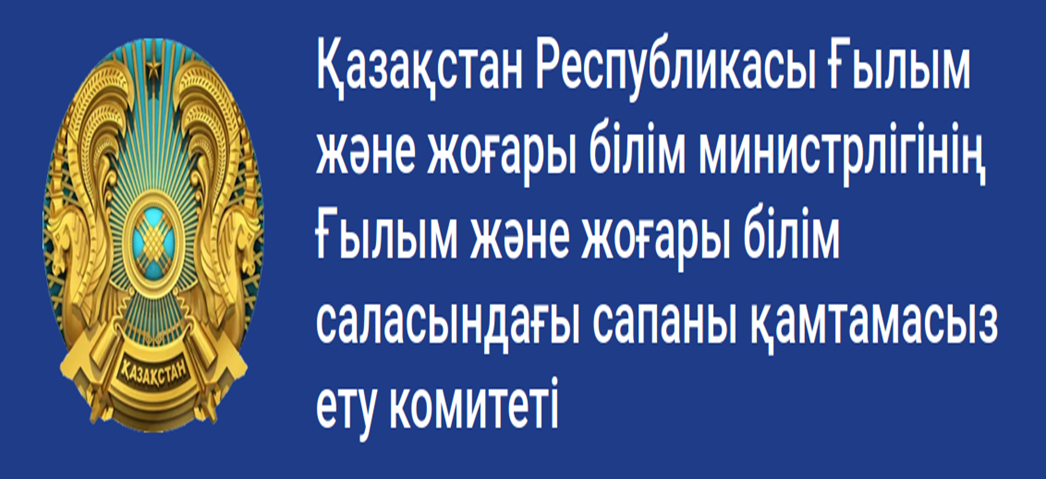Medieval Aktobe: between legend and reality
Views: 218 / PDF downloads: 126
DOI:
https://doi.org/10.32523/2664-5157-2025-2-44-63Keywords:
Middle Ages, Balasagun, Aktobe, settlement, legends, epic, citadel, shahristan, rabad, excavations, cross-section.Abstract
The land of Kazakhstan is a cradle of ancient civilizations. Throughout history, its vast steppes have been home to hundreds of cities, settlements, and majestic caravanserais
that emerged during the ancient and medieval periods. These urban centers were not only significant for the local population but were also widely recognized across Asia and Europe. With their impressive architecture, vibrant commercial activity, and cultural importance, they became true hubs of civilization. Travelers and merchants were captivated by their uniqueness, and many left behind detailed accounts in their writings. However, many of these remarkable cities and settlements could not withstand the trials of time. Bloody invasions, power struggles, internal conflicts, and foreign conquests led to the destruction and decline of numerous cultural centers. Today, what remains are silent witnesses to history, nameless hills and mounds marking the locations where once-thriving cities stood.
Nevertheless, the historical significance of these sites remains undiminished. These former centers of education, trade, and craftsmanship live on in the collective memory of the Kazakh people, preserved through oral traditions, genealogies, and especially the nation's rich folklore.
Kazakh legends and epic tales, transmitted orally across generations, contain valuable and unique insights into the lives and cultures of ancient cities. Alongside archaeological evidence and written sources, this oral heritage plays a vital role in reconstructing the history of Kazakhstan’s medieval urban centers. These cities, especially those located along the Silk Road, demonstrate that the region was not solely defined by nomadic life, but also by a flourishing urban civilization.
One such historical site is the Aktobe settlement.
This article explores the dual nature of medieval Aktobe by examining both historical facts and legendary narratives. It raises a central question: “Is there truth behind the legends?” For nearly a century, Aktobe has attracted the attention of archaeologists as a significant medieval site. Folklore and historical records about Aktobe often complement each other. In many legends, Aktobe is depicted as a center of learning, culture, and enlightenment. These narratives provide a glimpse into the lived reality and enduring legacy of this ancient city.
Downloads
Reference
Әбдуәли Қ., 2004. Қаңлы (тарихи шежіре). Алматы. «Дайк-Пресс» баспасы. 610 б.
Әуезов М., 1962. Уақыт және әдебиет. Алматы: Қазақстың Мемлекеттік көркем әдеби баспасы. 428 б.
Валиханов Ч.Ч., 1961. Заметки по истории южно-сибирских племен // Сочинения в 5-ти томах. Алма-Ата: Изд-во АН Каз ССР. Т.1. 391 б.
Валиханов Ч.Ч., 1961. Исторические предания о батырах XVIII века // Сочинения в 5-ти томах. Алма-Ата: Изд-во АН Каз ССР. Т.1. 220-227 бб.
Ел қазынасы ескі сөз. 1994. В.В. Радлов жинаған қазақ фольклорының үлгілері. Алматы. 616 б.
Елеуов М., 2012. Ортағасырлық Ақтөбе қаласының зерттелу тарихы: Жоғары оқу орны студенттеріне арналған оқу құралы. Алматы: Қазақ университеті. 105 б.
Елеуов М., 2016. Ескерткіштер жинағы. Алматы: Қазақ университеті. 158 б.
Елеуов М., Талеев Д., Есенов С., 2017. Шу-Талас өңірінің ұзын қорғанды қалалары / жауапты ред. Ерсариев А.М. Mонография. Алматы: Қазақ университеті. 114 б.
Елеуов М., 2021. Ортағасырлық Ақтөбе қаласының қорғаныс жүйесі. Қазақ университеті. Алматы. 106 б.
Казахский фольклор в собрании, 1972. Г.Н. Потанин (Архивные материалы и публикации). Алма-Ата. 379 с.
Қазақ әдебиетіінің тарихы, 2008. Он томдық. Алматы: ҚазАқпарат. Т.3. 536 б.
Қазақтың халық творчествосы, 1989. (Ә. Диваев жинаған материалдар). Aлматы: Ғылым. 416 б.
Қасқабасов С., 1984. Қазақтың халық прозасы. Алматы: Ғылым. Ана тілі. 272 б.
Қасқабасов С., 2009. Ойөріс. Алматы: Жібек жолы. 303 б.
Қоңыратбаев Ә., 1991. Қазақ фольклорының тарихы // Құрастырып алғы сөзін жазған Ә. Қоңыратбаев. Алматы. 288 б.
Марғұлан Ә., 1985. Ежелгі жыр аңыздар: Ғылыми-зерттеу мақалалар // Құрастырған Р.Бердібаев. Алматы: Жазушы. 368 б.
Потанин Г.Н., 1917. Казак-киргизские алтайские предания, легенды и сказки. Петербург. 47-71 б.
Уәлиханов Ш.Ш., 2010. Оңтүстік Сібір тайпаларының тарихы туралы жазбалар // Ш.Ш.Уәлиханов. Көп томдық шығармалар жинағы. 1 том /2 басылым. Алматы: Толағай групп. 248-258 .
Уәлиханов Ш.Ш., 2010 а. Қырғыздар туралы жазбалар // Уәлиханов Ш.Ш. Көп томдық шығармалар жинағы. 2 том / 2 басылым. Алматы: Толағай групп. Б. 8-10.
Шалекенов У.Х., 1980. Актобе – средневековый памятник // История материальной культуры Казахстана. Алма-Ата. Б. 13-20.
Шалекенов У.Х., Оразбаев А.М., 1980. Некоторые данные о водопроводной системе средневекового города Актобе // История материальной культуры Казахстана. АлмаАта. Б. 24-38.
REFERENCE
Аbdualï, Q., 2004. Qañlı (tarïxï şejire) [Qangly (Historical Genealogy)]. Almaty: Daik-Press. 610 p. [in Kazakh].
Áuezov, M., 1962. Uaqyt jáne ádebïet [Time and Literature]. Almaty: Qazaqtyń Memlekettik Kórkem Ádebï Baspasy. 428 p. [in Kazakh].
Ualïhanov, Ch.Ch., 1961. Zametki po istorïi yujno-sibirskikh plemen [Notes on the History of Southern Siberian Tribes]. In Sochinenïya v 5-ti tomakh. Alma-Ata: Izd-vo AN Kaz SSR. 391 p. [in Russian].
Ualïhanov, Ch.Ch., 1961. Istorïcheskie predanïya o batïrakh XVIII veka [Historical Legends about Batyrs of the 18th Century]. In Sochinenïya v 5-ti tomakh. Alma-Ata: Izd-vo AN Kaz SSR. pp. 220-227. [in Russian].
El qazınasy eski sóz, 1994. B.B. Radlov jïnağan qazaq folklorınıñ ülgileri [National treasure is an old saying (Samples of Kazakh folklore collected by В.В. Radlov)]. Almaty. 616 p. [in Kazakh].
Elewov M., 2012. Ortağasırlıq Aqtöbe qalasınıñ zerttelw tarïxı: Joğarı oqw ornı stwdentterine arnalğan oqw quralı [The history of the exploration of the medieval city of Aktobe: A textbook for university students]. Almatı: Qazaq wnïversïteti. 105 p. [in Kazakh].
Elewov M., 2016. Eskertkişter jïnağı [Collection of monuments] Almaty: Kazakh university. 158 p. [in Kazakh].
Elewov M., Taleev D., Esenov S., 2017. Şu-Talas öñiriniñ uzın qorğandı qalaları [Long-mounded cities of the Shu-Talas region]. jawaptı red. Ersarïev A.M. Monografïya Almaty: kazakh university. 114 p. [in Kazakh].
Elewov M., 2021. Ortağasırlıq Aqtöbe qalasınıñ qorğanıs jüyesi [The defense system of the medieval city of Aktobe]. Kazakh university. Almaty. 106 p. [in Kazakh].
Kazakhskiy fol'klor v sobranii, 1972. G.N. Potanina (Arkhivnyye materialy i publikatsii) [Kazakh folklore in collection. G.N. Potanina (Archival materials and publications)]. Alma-Ata. 379 p. [in Russian].
Qazaq ädebïetiiniñ tarïxı, 2008. On tomdıq [History of Kazakh literature (Ten volumes)]. Almaty: KazAkform. V. 3. 536 p. [in Kazakh].
Qazaqtıñ xalıq tvorçestvosı (Ä. Dïvaev jnağan materïaldar), 1989. [Kazakh folk art (Materials collected by A. Divaev)]. Almaty: Nauka. 416 p [in Kazakh].
Qasqabasov S., 1984. Qazaqtıñ xalıq prozası [Kazakh folk prose] Almaty: Nauka, Ana tili. 272 p [in Kazakh].
Qasqabasov S., 2009. Oyöris [Thoughts]. Almatı: Jibek jolı. 303 p. [in Kazakh].
Qoñıratbaev Ä., 1991. Qazaq folklorınıñ tarïxı [History of Kazakh folklore]. Qurastırıp alğı sözin jazğan Ä., Qoñıratbaev. Almatı. 288 p. [in Kazakh].
Marğulan Ä., 1985. Ejelgi jır añızdar: Ğılımï-zerttew maqalalar [Ancient Poems and Legends: scientific research articles]. Qurastırğan R. Berdibaev. Almatı: Jazwşı. 368 p. [in Kazakh].
Potanin G.N., 1917. Kazak-kirgizskiye altayskiye predaniya, legendy i skazki [Cossack-Kyrgyz Altai legends, legends and fairy tales]. Peterburg. P. 47-71 [in Russian].Wälïxanov Ş.Ş., 2010. Oñtüstik Sibir taypalarınıñ tarïxı twralı jazbalar [Notes on the history of the tribes of South Siberia]. Ş.Ş. Wälïxanov. Köp tomdıq şığarmalar jïnağı. 1 tom /2 basılım.Almaty: Tolagai group. P. 248-258 [in Kazakh].
Wälïxanov Ş.Ş., 2010a. Qırğızdar twralı jazbalar [Notes on the Kyrgyz]. Wälïxanov Ş.Ş. Köp tomdıq şığarmalar jïnağı. 2 tom / 2 basılım. Almaty: Tolagay Group. P. 8-107 [in Kazakh].
Shalekenov U.Kh., 1980. Aktobe – sredenvekovyy pamyatnik [Aktobe – a medieval monument]. Istoriya material'noy kul'tury Kazakhstana. Alma-Ata. P. 13-20. [in Russian].
Shalekenov U.Kh., Orazbayev A.M., 1980. Nekotoryye dannyye o vodoprovodnoy sisteme srednevekovogo goroda Aktobe [Some data on the water supply system of the medieval city of Aktobe]. Istoriya material'noy kul'tury Kazakhstana. Alma-Ata. P. 24-38. [in Russian].
Downloads
Published
How to Cite
Issue
Section
License
Copyright (c) 2025 Turkic Studies Journal

This work is licensed under a Creative Commons Attribution-NonCommercial 4.0 International License.


























